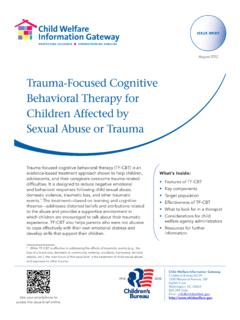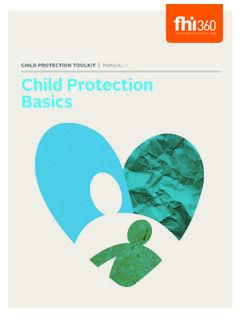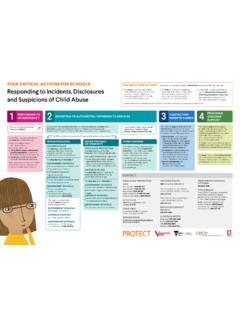Transcription of SEXUALITY EDUCATION - News
1 SEXUALITY EDUCATION : WHAT IS IT?This policy brief provides an overview of key issues in SEXUALITY EDUCATION . It focuses primarily on SEXUALITY EDUCATION in Europe and Central Asia but is also relevant to countries outside of these In Europe, SEXUALITY EDUCATION as a school curriculum subject has a histo-ry of more than half a century. It first began in Sweden in 1955, followed by many more Western European coun-tries in the 1970s and 1980s. The in-troduction of school-based SEXUALITY EDUCATION continued into the 1990s and early 2000s, first in France and the United Kingdom and subsequently in Portugal, Spain, Estonia, Ukraine and Armenia. In Ireland, SEXUALITY EDUCATION became mandatory in pri-mary and secondary schools in focus of SEXUALITY EDUCATION has changed in line with the educational and public health priorities of the time, but most key elements have stayed the same. It started with the prevention of unintended pregnancy (1960s-70s), then moved on to the pre-vention of HIV (1980s) and awareness about sexual abuse (1990s), finally embracing the prevention of sexism, homophobia and online bullying from 2000 onwards.
2 Today, an analysis of gender norms and reflections on gen-der inequality are important parts of SEXUALITY the Standards for SEXUALITY EDUCATION in Europe the concept of holistic SEXUALITY EDUCATION is defined as follows: Learning about the cognitive, emotional, social, interactive and physical aspects of sexu-ality. SEXUALITY EDUCATION starts early in childhood and progresses through adoles-cence and adulthood. For children and young people, it aims at supporting and pro-tecting sexual development. It gradually equips and em-powers children and young people with information, skills and positive values to understand and enjoy their SEXUALITY , have safe and ful-filling relationships and take responsibility for their own and other people s sexual health and well-being. 1 DEFINITIONS exuality EDUCATION aims to develop and strengthen the ability of children and young people to make conscious, satis-fying, healthy and respectful choices regarding relationships, SEXUALITY and emotional and physical health.
3 sexual -ity EDUCATION does not encourage chil-dren and young people to have : Peter Barker / PanosPolicy brief No. 1 SEXUALITY EDUCATIONWHAT ARE THE BENEFITS OF SEXUALITY EDUCATION ? SEXUALITY EDUCATION delivered within a safe and enabling learning environment and alongside access to health services has a positive and life-long effect on the health and well-being of young people. Studies in several European coun-tries have shown that the introduction of long-term national SEXUALITY edu-cation programmes has led to a re-duction in teenage pregnancies and abortions and a decline in rates of sexually transmitted infections (STI) and HIV infection among young peo-ple aged 15 24 years. Beyond that, by increasing confidence and strengthen-ing skills to deal with different chal-lenges, SEXUALITY EDUCATION can em-power young people to develop strong-er and more meaningful relationships. Social norms and gender inequality influence the expression of SEXUALITY and sexual behaviour.
4 Many young women have low levels of power or control in their sexual relationships. Young men, on the other hand, may feel pressure from their peers to act according to male sexual stereotypes and engage in controlling or harmful behaviours. Good quality SEXUALITY EDUCATION has a positive impact on at-titudes7 and values and can even out the power dynamics in intimate rela-tionships, thus contributing to the prevention of abuse and fostering mutually respectful and consensual IMPORTANCE OF GOING BEYOND INFORMAL SEXUALITY EDUCATIONV arious social and technical develop-ments during the past decades have triggered the need for good quality SEXUALITY EDUCATION , which can enable young people to deal with their sexu-ality in a safe and satisfactory manner. Examples of these kind of develop-ments are: globalization and the arriv-al of new population groups with differ-ent cultural and religious backgrounds; the rapid spread of new media, par-ticularly the Internet, Internet pornog-raphy and mobile phone technology; the emergence of HIV and AIDS; in-creasing concerns about STIs, abor-tion, infertility and the sexual abuse of children and adolescents; and, last but not least, changing attitudes towards SEXUALITY and changing sexual behav-iour among young people.
5 Formalized SEXUALITY EDUCATION , as opposed to peer EDUCATION and extracurricular activi-ties, is well placed to reach a majority of children and young , relatives, friends and other laypersons are important sources of learning about human relationships and SEXUALITY , especially for younger age groups. However, informal sources are often insufficient, because of the complexity of knowledge and skills required when discussing about topics such as contraception, STIs, emotion-al development and communication. Many parents feel uncomfortable or unprepared to tackle SEXUALITY educa-tion themselves and are supportive of schools taking on this role. Moreover, young people often prefer to have additional sources of information other than their parents, because the latter are felt to be too , 7 Photo: UNFPA/ EECARO(a) Adolescents have the right to access adequate information essential for their health and development and for their ability to participate meaningfully in society.
6 It is the obligation of States parties to ensure that all adolescent girls and boys, both in and out of school, are provided with, and not denied, accurate and appropriate information on how to protect their health and development and practise healthy behaviours. This should include information on the use and abuse , of tobacco, alcohol and other substances, safe and respectful social and sexual behaviours, diet and physical activity. (CRC/GC/2003/4, para 26)(b) Committee on the Elimination of Discrimination against Women. General recommendation No. 28 on the core obligations of States parties under article 2 of the Convention on the Elimination of All Forms of Discrimination against Women ( ). See also the Beijing Dec-laration and Platform for Action of the Fourth United Nations Conference on Women (Beijing, China, 1995, ).(c) The Committee interprets the right to health, as defined in article , as an inclusive right extending not only to timely and appropriate health care but also to the underlying determinants of health, such as [.]
7 ] access to health-related EDUCATION and information, including on sexual and reproductive health. (Committee on Economic, Social and Cultural Rights, General Comment No. 14, para. 11, available from ).(d) Article 25 Health. United Nations Convention on the Rights of Persons with Disabilities. A/61/611, 6 December, 2006. (e) The 1994 ICPD Programme of Action (paragraphs , , , ) explicitly calls on governments to provide SEXUALITY EDUCATION to promote the well-being of ad-olescents and specifies key features of such EDUCATION . It clarifies that such EDUCATION should take place both in schools and at the community level, be age-appropri-ate, begin as early as possible, foster mature decision-making, and aim to advance gender equality. In addition, the Programme of Action urges governments and non-governmental organizations (NGOs) to ensure that such programmes address specific topics including gender relations and equality, violence against ado-les-cents, responsible sexual behaviour, contraception, family life, and STIs, HIV and AIDS prevention ( ).
8 (f) A/65/162, 2010. Report of the United Nations Special Rapporteur on the right to EDUCATION : sexual EDUCATION . United Nations, 2010.(g) Four families had lodged a complaint because they opposed mandatory SEXUALITY EDUCATION in Germany. The Court stated that the neutral transmission of knowledge is a prerequisite for developing one s own moral standpoint and reflecting society s influences in a critical way. The Court ruled in favour of Germany. European Court of Human Rights, AND FACTS ABOUT SEXUALITY EDUCATIONGood quality SEXUALITY EDUCATION does not lead to young people having sex ear-lier than is expected based on the na-tional average. This has been shown in research studies in Europe, including Finland7 and Estonia8, and in research from other countries around the world. Good quality SEXUALITY EDUCATION can, however, lead to later sexual debut and more responsible sexual , 9 SEXUALITY EDUCATION does not deprive children of their innocence.
9 Giving children information on SEXUALITY that is scientifically accurate, non-judge-mental, age-appropriate and com-plete, as part of a carefully phased process from the beginning of formal schooling (including kindergarten and pre-school) is something from which children can EDUCATION and an open atti-tude towards SEXUALITY do not make it easier for paedophiles to abuse chil-dren. The opposite is the case: when children learn about equality and re-spect in relationships, they are in a bet-ter position to recognize abusive per-sons and situations. In the absence of this, children and young people can look for and receive conflicting and some-times damaging messages from their peers, the media or other EDUCATION is not damaging to children or SEXUALITY ed-ucation encompasses a range of topics that are tailored to the age and devel-opmental level of the child. This is what is called age-appropriateness. A child aged four to six years learns for example about topics such as friend-ships, emotions and different parts of the body.
10 These topics are also rele-vant for older children and adoles-cents but are then taught at a different level. Gradually, other topics such as puberty, family planning and contra-ception are introduced. For most young adults, sexual relationships are built on principles similar to those of the social relationships learnt in early life. Children are aware of and recog-nize these relationships long before they act on their SEXUALITY and there-fore need the skills to understand their bodies, relationships and feelings from an early SEXUALITY EDUCATION AND HUMAN RIGHTSGood quality SEXUALITY EDUCATION is grounded in internationally accepted human rights, in partic-ular the right to access appro-priate health-related informa-tion. This right has been con-firmed by the United Nations Committee on the Rights of the Child(a), the Committee on the Elimination of Discrimination against Women(b), the Commit-tee on Economic, Social and Cultural Rights(c) and also in the United Nations Convention on the Rights of Persons with Disabilities(d).















